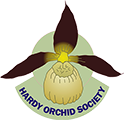
Orchid Meadows & Wilding
Encouraging orchid species to grow and increase within a particular site can be part of what are often and variously called:
- Creating an orchid meadow
- Wilding or rewilding
- Restoration ecology
For a discussion of what these often ill-defined terms might involve see Rewilding & other methods of ecological restoration/Orchid Meadows and rewilding.
HOS strongly advises that when orchid introductions take place outside of a domestic garden there should be clear planning and stated objectives. The greatest care should be taken with what species are introduced and how introductions are recorded and monitored. Successful introductions should be reported to your County Recorder or to Botanical Society of Britain & Ireland (BSBI).
For a guide to the plant recording system and the role of BSBI see Current status of Botanical Recording in Britain and Ireland.
Regardless of the scale or ambition of your project encouraging, protecting and introducing wild orchids within a plot will require some practical steps.
Choosing a suitable site for orchids
Orchids grow best in impoverished soil, but other factors are significant including aspect, rainfall, drainage and pH. The presence of the correct mycorrhizal fungus in the soil is also significant to a greater or lesser extent depending on the species of orchid. Former agricultural land and domestic lawns which have been regularly fertilized will not support the more sensitive species of orchid but regular cutting and removal of the hay may reduce competition and stabilize or slightly lower the fertility enough to allow more robust and locally common species to establish.
Removal of the top-soil has been used but is extremely expensive due to transport and disposal costs as well as being environmentally questionable.
If there is historical evidence of a species occurring locally then reintroduction might be considered bearing in mind that there will be no knowledge of why the species was lost or where, on a large site, they originally grew.
For information on where in the UK orchid species occur:
- Your local Wildlife Trust website will include information on species present at local reserves.
- The BSBI On-line Atlas
- A modern and comprehensive orchid guide will include soil and site preferences and distribution density. e.g. Cole S. & Waller M. Britain’s orchids Princeton UP 2020
Introducing appropriate species
A landowner can plant anything on their land unless it is a banned plant e.g. Japanese Knotweed or a protected species.
Orchids are introduced into a site either as seed or as plants.
Your project will be most successful if you grow orchids known to occur locally as these will be most likely to thrive in local conditions.
Introducing seed or plants only found elsewhere in the UK and foreign seed/species is controversial and advice is to not plant or sow non-local, non-native species. If species are to be found locally then only locally sourced seed or plants should be used so the genetic variability of plants on sensitive sites nearby such as nature reserves and SSSI’s is not compromised. As bees forage over at least a five-mile radius this should be up to within a ten-mile radius. Any successful introductions should be notified to your County Recorder or to BSBI.
Obtaining orchid seed:
- Local landowners with orchids will often give permission for small amounts of seed to be collected.
- Wildlife Trusts may give permission for small amounts of common species to be collected or may sell orchid seed.
- HOS members donate seed to the HOS Seed Bank which is available to members for a small charge.
For information on introducing orchids by seed see Creating an orchid meadow using seed. Also on YouTube
Orchid species can be introduced as mature plants although success may be limited unless the plants are maintained carefully through their first couple of years in soil. Symbiotically raised plants may be more successful as the appropriate mycorrhizal fungus may not be present on your site.
HOS runs a workshop annually on propagating orchids from seed.
Encouraging existing species to increase
Reducing the regular mowing of garden lawns and restoration/clearance of overgrown sites will sometimes allow orchids that have survived underground to complete their life cycle; flower and set seed.
An example is Plantlife's No Mow May campaign.
To encourage these to increase and spread:
- Pay particular attention to the correct mowing regime appropriate to the species.
- Hand pollinate the orchids using a cocktail stick to transfer the pollen to another plant.
- Collect and scatter ripe seed around parent plants having first scratched the soil surface. See Creating an Orchid Meadow using seed. Also on YouTube
- Collect ripe seed and propagate it then reintroduce the adult pot-grown plants. See GO HERE for information on seed propagation and orchid cultivation.
- Study the soil and site preferences of orchids that are present and maintain or increase these areas of your site.
Maintenance of an orchid rich site
Whether orchids are found to be present at a site or are introduced, the area in which they grow will need maintaining in order to support and increase their number.
Competing coarser grasses and plants must be controlled by mowing or cutting at times appropriate to the species of orchid present and the cuttings removed.
Use of insecticides and other chemicals should be minimised to protect the balance of organisms present.
Advice on managing a range of landscape types, particularly larger areas and habitats can be found at Plantlife.